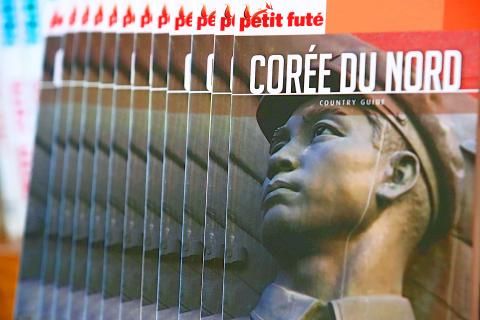A French travel publisher presented Tuesday its first guide book for North Korea, offering 190 pages of tips for getting the most out of a trip to experience the “survival of a totalitarian communist state.”
“The guide wasn’t conceived to defend the current regime or to cast judgment, but to show the genuine touristic interest of the country,” Jean-Paul Labourdette, a co-founder of the Petit Fute guides, said in Paris.
He said 4,000 copies had been printed — more than enough for the estimated 400 French tourists who head each year to the pariah state, which has been isolated from the international community for decades.

Photo: Reuters
North Korea has endured harsh UN sanctions to pursue its nuclear weapons program under the Kim dynasty, which implemented a dictatorship that has been accused of provoking widespread hunger and human rights abuses.
The French foreign ministry strongly discourages tourists from visiting, while the US State Department only rarely grants exceptional permits for Americans hoping to travel to North Korea.
But Labourdette said “there are no security issues” for travelers, though he admitted “very restrictive” conditions, not least tight surveillance that limits foreigners to just a handful of hotels and restaurants.
And while tourist visas are readily granted, the guide warns that missteps are costly: “The punishments can be severe... as was the case for the American student Otto Warmbier.”
Warmbier, an Ohio native who studied at the University of Virginia, was pulled away from his tour group at the Pyongyang airport in 2016 and charged with crimes against the state for allegedly taking down a propaganda poster in his hotel. He was sentenced to 15 years of hard labor. After lengthy negotiations between Washington and Pyongyang, Warmbier was released in a vegetative state in 2017 but died a few days later on American soil.
‘DON’T TAKE PICTURES’
Mainstream travel guides have steered clear of the repressive nation, with English-language stalwarts like Lonely Planet limiting their coverage to a few chapters in their Korea books.
“Don’t take any pictures of airports, roads, bridges or train stations,” the Petit Fute warns, and make sure you don’t throw away or even fold any newspaper with a picture of former or current leaders.
“Roll it up instead,” the guide advises.
The book comes as North Korean leader Kim Jong-un and US President Donald Trump are holding halting talks on ending the country’s nuclear weapons efforts.
“We launched this project four years ago, we didn’t wait for Donald and Kim to start their little friendship,” Labourdette said. “But it took quite a while to find qualified French writers.” Petit Fute aims to publish guides on all the world’s countries, or 204 instead of the 175 it covers now.

In the March 9 edition of the Taipei Times a piece by Ninon Godefroy ran with the headine “The quiet, gentle rhythm of Taiwan.” It started with the line “Taiwan is a small, humble place. There is no Eiffel Tower, no pyramids — no singular attraction that draws the world’s attention.” I laughed out loud at that. This was out of no disrespect for the author or the piece, which made some interesting analogies and good points about how both Din Tai Fung’s and Taiwan Semiconductor Manufacturing Co’s (TSMC, 台積電) meticulous attention to detail and quality are not quite up to

April 21 to April 27 Hsieh Er’s (謝娥) political fortunes were rising fast after she got out of jail and joined the Chinese Nationalist Party (KMT) in December 1945. Not only did she hold key positions in various committees, she was elected the only woman on the Taipei City Council and headed to Nanjing in 1946 as the sole Taiwanese female representative to the National Constituent Assembly. With the support of first lady Soong May-ling (宋美齡), she started the Taipei Women’s Association and Taiwan Provincial Women’s Association, where she

Chinese Nationalist Party (KMT) Chairman Eric Chu (朱立倫) hatched a bold plan to charge forward and seize the initiative when he held a protest in front of the Taipei City Prosecutors’ Office. Though risky, because illegal, its success would help tackle at least six problems facing both himself and the KMT. What he did not see coming was Taipei Mayor Chiang Wan-an (將萬安) tripping him up out of the gate. In spite of Chu being the most consequential and successful KMT chairman since the early 2010s — arguably saving the party from financial ruin and restoring its electoral viability —

It is one of the more remarkable facts of Taiwan history that it was never occupied or claimed by any of the numerous kingdoms of southern China — Han or otherwise — that lay just across the water from it. None of their brilliant ministers ever discovered that Taiwan was a “core interest” of the state whose annexation was “inevitable.” As Paul Kua notes in an excellent monograph laying out how the Portuguese gave Taiwan the name “Formosa,” the first Europeans to express an interest in occupying Taiwan were the Spanish. Tonio Andrade in his seminal work, How Taiwan Became Chinese,